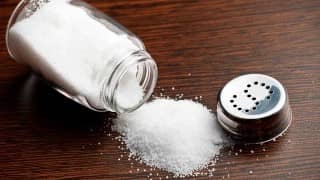
Common salt or sodium chloride (NaCl ) is a remarkable substance which flavours all our preparations.
Formerly, when the refrigerator did not exist, salt was used to preserve food in good condition.
But now that our houses are equipped with refrigerators, we continue salting all our food, and too much.
How can salt be replaced in food ?
What substitute can be chosen ?
Maximum Salt Intake
The World Health Organization (WHO) recommends no more than 5 grams per day. Canada and the United States, the Tolerable Upper Intake Level (UL) is set at 2.3 g sodium or 5.84 g of salt.
However, statistics show that 70% of people consume 10 to 15 grams per day, which is dangerous for health. It is interesting to note that the real nutritional requirements of salt is 3 grams per day.
Salt, Sodium and Conversion Factor
When doctors talk about salt, in reality they refer to sodium. One gram of table salt or kitchen contains 0.4 g of sodium. Sodium is an important substance for the body, but only in small doses.
Nutrition labeling of foods marketed often mentions sodium. To get the equivalent value for salt, multiply this figure by 2.54 (conversion factor of sodium to salt).
For example, if you read on the label of a 100 g serving of ham contained 130O mg sodium, do the math in this way to find its equivalent in salt : 1.300 X 2.54 = 3,25 g of salt.
Excess Salt and Health Consequences
If too little sodium in our diet can create health problems, overuse can also cause negative consequences. Excess sodium is involved or may be responsible for cardiovascular and renal diseases.
Excessive consumption of salt increases the risk of the following conditions: stroke, gastrointestinal cancer, hypertension, osteoporosis, heart problems, gout problems, water retention, uric acid disorders and stomach ulcers.
The researcher Pierre Meneton (INSERM) makes salt responsible for more than 75,000 cardiovascular events and 25,000 deaths each year in France.
Foods that Contain More Sodium
A mere reduction in salt or table salt is far from sufficient in the context of a controlled sodium diet. Indeed, 70 % of the salt we eat comes mostly dishes and foods consumed in fast food.
Other foods involved in the overconsumption of salt are preserved foods (except those labeled » No added salt »), cheeses, meats, breads, cereals, cookies, crackers, packet soups, dried fruit, bottled dressings, condiments (ketchup, mustard and pickles), carbonated waters and aerated fruit juices.
For example, each of the following food portions contain one gram of salt: a slice of ham, 50g camembert, 50 g pâté (Country-style Pâté) and 3 sardines in oil.
Prescription : Low-Salt Regime
You certainly understand when people talk about ‘salt-free diet’, it refers to a low-sodium diet, that is to say low in salt. There are three types of low sodium diets: the wide sodium diet providing 1000 to 2000 mg of sodium per day, standard sodium diet providing 500 to 1,000 mg of sodium per day and strict sodium diet providing 300 to 350 mg of sodium per day.
Doctors usually recommend to patients who suffer from hypertension to limit their salt intake. In fact, between 30 and 50% of hypertensive individuals are sensitive to salt. In this case, it has been shown that less salt intake decreased blood pressure.
Here are 6 rules for controlling salt intake :
1) Consume a minimum of industrial products and favour « home » cooking. Read the nutrition labels to find out the amount of sodium contained in processed foods that you are about to buy.
2) Wherever possible, avoid canned foods with added salt or rinse the food in these boxes (beans, tuna, etc.) thoroughly.
3) Do not add salt to the boiling water you use to cook pasta or vegetables. Limit the use of the following salts: table salt, sea salt, celery salt, garlic salt, onion salt, Himalayan salt, and monosodium glutamate.
4) Avoid soft drinks.
5) Season your food with herbs to add flavor and prevent the intake of salt in cooking.
6) Use salt substitutes as a last option.
Substitutes for Salt and Low – Sodium Diet
1) Salt substitutes called diet salt are available on the market (pharmacies in particular), Bouillet ® salt, salt Diasal ®, salt XaI ® are some of the specialties that do not contain sodium. However, these salt substitutes contain potassium. Ask your doctor for advice before usage, because, for some people, too much potassium can cause other health problems.
2) An alternative is to use other spices, seasonings and condiments such as salt substitutes. Spices are used to add flavor to foods. You can use the pepper, oregano, basil, tarragon, thyme, sage, bay leaf, cloves, coriander, nutmeg, chervil, celery, fennel, rosemary, parsley, chives, mint, cinnamon, vanilla, curry, saffron, cumin, dill, paprika, ginger, onion, shallot, leek, garlic, etc. All these spices contain flavors that become salt substitutes.
3) Use flavoring oils (olive oil, nuts, etc.) and flavored vinegars (tarragon, herbs, etc.).
4) Another interesting option is to marinate the meat. Marinate the meat with lemon juice, orange juice, olive oil and herbs. Food is allowed to marinate a few hours in the refrigerator before cooking. Thus, the taste of food is enhanced, without the addition of one gram of salt!
Author : Alexis ROGER
The Bloodpressure Program
New research reveals that one single organ is responsible for almost all cases of high blood pressure.
Contrary to what you may think it’s NOT:
- the heart
- the kidneys
- the arteries
…or any other cardiovascular organ.
By addressing the one organ responsible you can lower your blood pressure without:
- medications
- supplements
- diet changes
- strenuous exercises
In fact, you can lower your blood pressure from home in an extremely pleasurable, relaxing way.
Not only will you lower your blood pressure, you’ll also address any damage already done to your arteries.